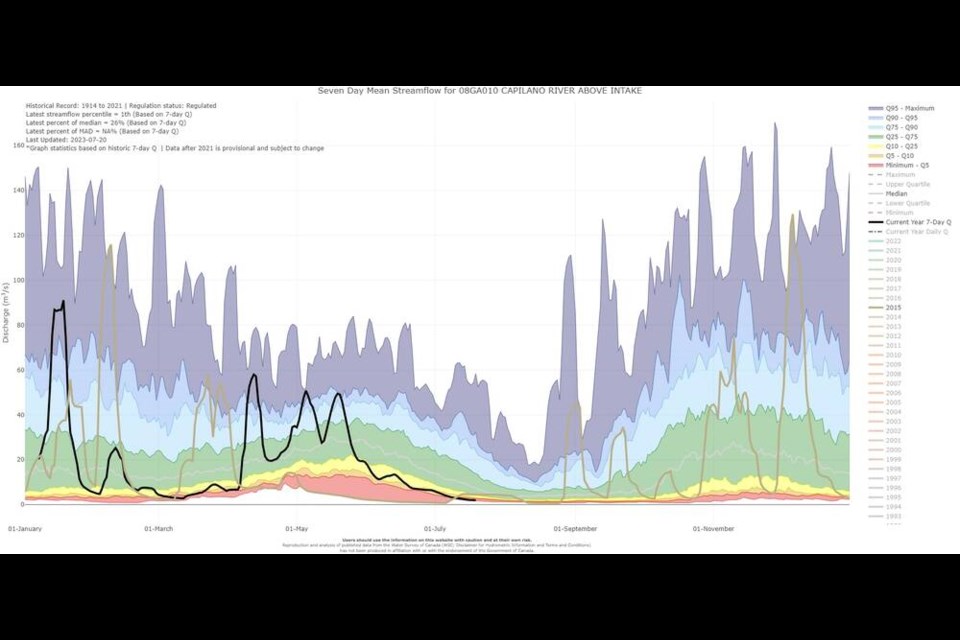Water flowing into Capilano Lake – one of three critical reservoirs that supply Metro Vancouver with fresh water – has reached the second-lowest level in recorded history.
Since data started being collected in 1914, inflow into the reservoir was only lower in 2015, a year when there was virtually no snowpack, according to Jesse Montgomery, division manager of environmental management for Metro Vancouver.
Lower flows happen during the summer months most years, but what’s different in 2023 is that we’re seeing these lower values much earlier, Montgomery explained.
“Typically, we’d see our lowest of low flows about a month from now,” he said.
One of the most important drivers of flows into local reservoirs is snowpack, which was normal in terms of water storage equivalent, Montgomery said.
"However, because we had such a hot, dry spring, we lost the snowpack really quickly, which accelerated the timing of when the low flows arrived for the season.”
The province has deemed the condition of Capilano Lake to be Drought Level 5, the highest on the 0-5 scale, which compares flow conditions to historical data for the same time of year. According to provincial data, two-thirds of B.C.’s water basins are at Drought Level 4 or 5 as of July 20.
Metro Vancouver asks residents to conserve water before stricter measures issued
In part due to the strong snowpack, reservoir levels are currently within the normal range: 233.55 billion litres as of July 16. On the same date in 2015, there was a combined 196.21 billion litres in the Capilano, Seymour and Coquitlam reservoirs, according to Metro Vancouver data. Those three bodies of water supply the entire regional district with drinkable water.
But the biggest driver of increased water consumption during the summer months, versus the winter months, isn’t hydration. It’s watering lawns.
A typical high-demand day in the summer is about 1.5 billion litres for Metro Vancouver, compared to roughly 1 billion in the winter. In a statement issued Friday, the regional district said the highest-demand day so far this year was July 5, at 1.56 billion litres.
July 5 was not a designated lawn-watering day and so Metro is reminding residents that $250 fines can be issued to anyone violating watering rules during current Phase 1 restrictions. While Metro encourages residents to stop watering their lawns altogether, the activity is currently allowed for even-numbered addresses on Saturdays and odd-numbered on Sundays in the morning.
“We’re asking everyone to go out of their way to conserve water to the greatest extent possible, including minimizing lawn watering,” Montgomery said. Other suggested ways to reduce water consumption is taking shorter showers and only doing full loads of laundry.
If there aren’t extra gains in conservation, restrictions could move to a higher level to prioritize conservation of drinking water. At that stage, lawn watering would be banned outright.
“It’s not necessary to get to that level,” he said. “But given the hot, dry weather and the high water use this year, we’re really asking that everyone to make their conservation effort, so that we don’t need to go to extra measures.”
As low flows affect local streams and rivers, habitat for salmon and other fish comes under threat. On Friday, Metro said it released water from Cleveland Dam to support Coho salmon returning to the Capilano River Hatchery, highlighting that reservoirs must also support fish populations in addition to providing drinking water for people.


